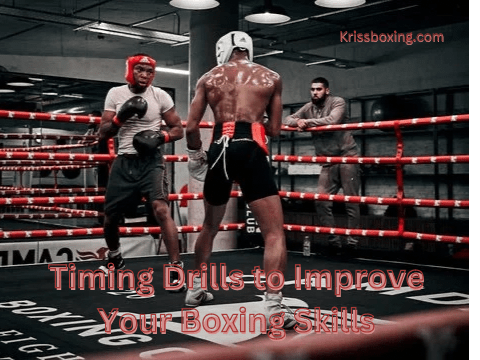It is widely said that timing is the missing art of boxing. The importance is not so much how fast one is or how heavy a punch one can pack, but when a particular strike gets through.
Timing enables a person to grab a sudden opportunity, dodge a blow, or move out of the danger zone at the right time.
This article seeks to illustrate how the timing of drills could make such a huge difference that you would be turned from being just a good boxer into a great one.
The Science Behind Timing in Boxing
Timing in boxing is the ability to coordinate your movements with that of the opponent. This means being able to guess what their next move would be and responding to that.
In timing there is no reaction, it is closer to prediction, and that is as close as you get. Such a performance, as we can see, consists in being able to ‘read’ the intentions of the opponent and react to them accordingly, which makes a crucial difference between the top-notch boxers and the others.
Timing can be broken down into several components: such factors as reaction time, speed, rhythm, and distance management.
It is the time it takes to make a response to a stimulus, for example, an opponent’s strike. Speed is the extent to which one can execute his or her response.
Rhythm is the ability to identify the frequency that an opponent fights and be able to counter it. Last of all, distance management is important as to when to close or open the distance to deliver a punch or to avoid receiving one.
The Role of Timing Drills in Skill Development
These components are exactly what timing drills are meant to enhance. They condition your muscles to respond automatically and your brain to identify and memorize the signals of the opponent.
By consistently practicing these drills, you are sure to have your reflexes fast, improve in accuracy, and more confident in the handling of the pace of the fight.
- Slip Rope Drill: Slip rope drill is among the best timing drills; the drill aims at creating an understanding of the stop-and-go concept. The experiment is carried out with a rope hanging across a room at a height of about the person’s shoulders. The boxer moves around the rope and practices how to slip punches, body, and foot balance. This drill helps the co-coordinating aspects of your defense or technique about your competitor’s punches.
- Focus Mitt Work: Timing is well fine-tuned with focus mitts. Indeed, when with a trainer, they must shout or point to the specific punches that you are supposed to land, and they have to be fast and accurate. Some of the calls the trainer makes are random, and this gives fluent training on what happens during a fight.
- Double-End Bag Training: Finally, the double-end bag is a perfect piece of equipment that helps to improve the aspect of timing. This is a fast and jerky bag, which you have to throw punches at with the appropriate force in appropriate places. This drill is useful in practicing hand-to-eye co-ordination and in addition, learning the right time to throw a punch when the target is on the move.
- Shadowboxing with Timing Focus: And so, shadowboxing is not only about punches; it is about learning the rhythm that is to be followed by your actions. Take time and envisage an opponent standing across you and perform the punches, slips, and feet movements like in a typical fight. This drill improves your skills on how to keep the flow and tempo of the fight under check.
- Partner Timing Drills: Training on specific timing of drills in a controlled setting like partner-specific exercises in controlled sparring or reaction-based drills allows you to apply your timing skills to these drills. This practice is most useful in moving from straight practice to sparring or competition.
Applying Timing Drills in Sparring
In other words, it is ideal if timing drills are incorporated into your sparring in a way that they are not specifically recognized. It is best to use the slip rope or focus mitt work as your warm-up during training sessions.
Using the snack drill concept, the task becomes progressive in that as you advance you begin to incorporate the high-intensity drills that reflect your current level of fitness.
- Controlled Sparring: As a matter of starting point, you choose controlled sparring sessions in which the only aspect you concentrate on, is timing. Forget about energy or speed; instead, it is the right moment of the blow, the parry, the slip. This serves to enhance the timing skills that you had practiced during the drills.
- Reaction-Based Sparring: In this sparring mode they will just throw punches at random and your job is to slip, block, or counter appropriately. This assists in using your timing in pressure situations.
- Rhythm Disruption Sparring: Try to ‘break’ your opponent’s rhythm by altering the timing of your progress. Always aim some of your hits at the timings people are least expecting, and switch between fast and slow movements. Besides getting your timing right, it transforms you into a more difficult adversary to read and forecast.
- Footwork Timing: Reflexive timing of the footwork with the movements of your opponent is considered to be very important. Try stinging and moving in and out of striking clinches and range, and turning the opponent around you, all of this at the right time.
- Video Analysis: During your sparring type your strikes and those of your opponent and evaluate your timing. Seek areas where you think you could have moved more quickly or accurately and apply the emerging understanding to place corrections for the timing throughout subsequent sessions.
Frequently Asked Questions
Are timing drills suitable for beginners?
I have always considered timing drills as extremely valuable for boxers of any skill category. New users of the platform can engage in simple exercises and as they progress they increase the level of difficulty in the exercises.
Can timing drills benefit my defense?
Yes, timing drills are important for defensive movements since they teach a student how to counter an attack made by the opponent.
What are some key timing drills to practice?
Slip rope drills, focus mitt training, double-end bag training, shadowboxing, partner timing drills and many more are perfect for sharpening timing.
How can timing drills improve my boxing skills?
Timing drills help to better predict an opponent’s actions and your actions inside the ring will therefore be more accurate.
Conclusion
To be a good boxer it is a requirement that one has to practice the use of timing all the time. Timing drills are equally important in training and sparring, therefore by incorporating timing drills into your preparations, you are likely to improve your boxing. In both avoiding a strike and delivering one, timing is what determines how well your movements would flow.


